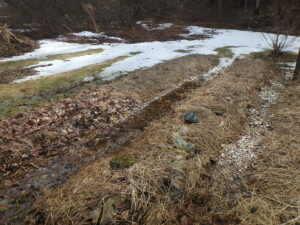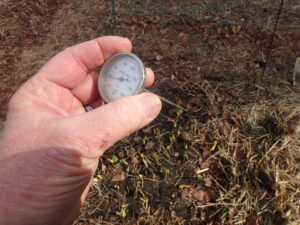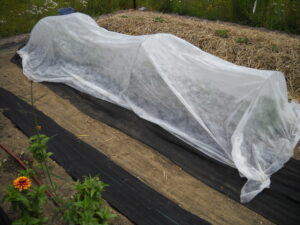I know some gardeners that plant their potatoes or tomatoes in the garden on the same day every year. Not me. I think planting time is best based not only on the last frost date in your garden, but also the soil temperature and up-to-date weather predictions. And of course, late frosts do occur unexpectedly and can wipe out your tomato or pepper seedlings. So don’t jump the gun.

These raised beds are draining nicely but are still too cold and wet to plant
The internet has many guides and suggestions for when you should plant, but I think an experienced next door neighbor probably has a better sense of when to plant. So, for example, one internet source says the last frost for Cornish Flat, NH is May 15, while another internet sources says June 11 to 20. That’s over a month of difference! But perhaps an old timer in your town can advise you, depending on your exact location.
My vegetable garden is in a low spot, with hills on either side. Cold air slides downhill, so I am cautious about planting too early. Often there is a late frost in my garden, but not around my house which is 15 or 20 feet uphill. Rivers, lakes and the ocean can have a warming effect, too. The closer you are to the Connecticut River or the Atlantic Ocean, the sooner you can plant.
It is often thought that a full moon will cause late frosts. But a friend of mine used the frost data his mother had collected over decades and compared it to the phases of the moon. He observed that the moon does not seem to affect frost dates.

Soil thermometers are useful tools for deciding when to plant
Soil temperature is important, too. Seeds are genetically programmed not to germinate if the soil is too cold. That makes sense: seedlings are tender and many can be damaged by frost. So you can plant spinach or peas seeds “as early as you can work the soil”, according the package, but they may not germinate for weeks if the soil is cold – and they may rot.
Seeds can rot in cold, wet soil. Corn seeds are particularly susceptible to rot, and many are treated with fungicides to prevent rotting. But as organic gardeners, we should avoid treated seeds.
If you are in a hurry, can warm up the soil. First, rake off any fall leaves or other mulch from you garden beds. That will allow the sun to warm the soil, and air to evaporate some of the melted snow and spring rains that make the soil soggy.
Raised beds help with drainage. My vegetable garden is near a stream and the water table is high, especially in spring when it is occasionally flooded. Each fall I shape my beds for spring, raking soil into the beds before covering them with leaves. In the spring I rake the leaves into the walkways, but after the soil has warmed up in mid-June I will put down hay and newspapers around my plants.
I you want to warm the soil and kill any annual weeds that start growing early in the season, you can cover the soil with clear plastic. If you get what is called “4-mil” plastic, you can re-use it. Flimsy stuff sold to painters is not usually reusable. Be sure to pin down the edges, or better yet, put soil or boards over the edges to keep wind from lifting the plastic and cooling the soil.
On a sunny day the temperature under the plastic can exceed 100 degrees, “solarizing” weeds and killing them. Perennial weeds and grasses will have their tops browned, but it will not kill the roots unless you do this for a long time.
So what seeds can you plant early? Spinach, peas, lettuce can be planted 3 to 6 weeks before last frost. In the fall I let a few lettuce plants flower and go to seed. Those seeds fall on the soil and start up much earlier than I plant any lettuce. But I also start lettuce indoors to get nice sized plants in the ground in May for early eating. Carrots, beets, onion sets and radishes can go in the ground a week or two before last frost.
Tomato, pepper and squash family seedlings I plant in mid-June, well after last frost because I want the soil to reach at least 60 degrees before planting. Because I am bothered by a beetle that eats my cukes and squash I start those indoors instead of by seed outdoors. When the vines are about 6 inches long I plant them outdoors. By then they will survive any beetle munching.
Before planting any seedling outdoors, be sure to harden off the plants. That means to start putting the seedlings outdoors a few hours a day and increasing their exposure over the period of a week or so. You should do this for store-bought seedlings, too, as they have probably been protected from sunburn and windburn inside a greenhouse. But ask at the nursery if they are hardened off.

Row cover with hoops helps to keep insects off and keep plants warm
You can protect seedlings from light frost by covering them with something called row cover, Reemay, or Agribon. These are spun agricultural fabrics that come in 5 foot wide swaths that you can cut to fit your rows. Unlike plastic sheeting, this stuff breathes and allows moisture to pass through it. Buy the wires sold to support it and form hoops over your plants. It will also keep bugs off your plants, but you need to remove it when vine crops start to bloom – they are insect pollinated.
The more you garden, the more you know. But we never know exactly when a late killing frost will come. So I am always the last on the block to get my garden planted – but my plants catch up.
Henry is a gardening consultant and the author of 4 gardening books. Reach him at
henry.homeyer@comcast.net or PO Box 364, Cornish Flat, NH 03746. Please include a SASE if you wish a response by mail.





